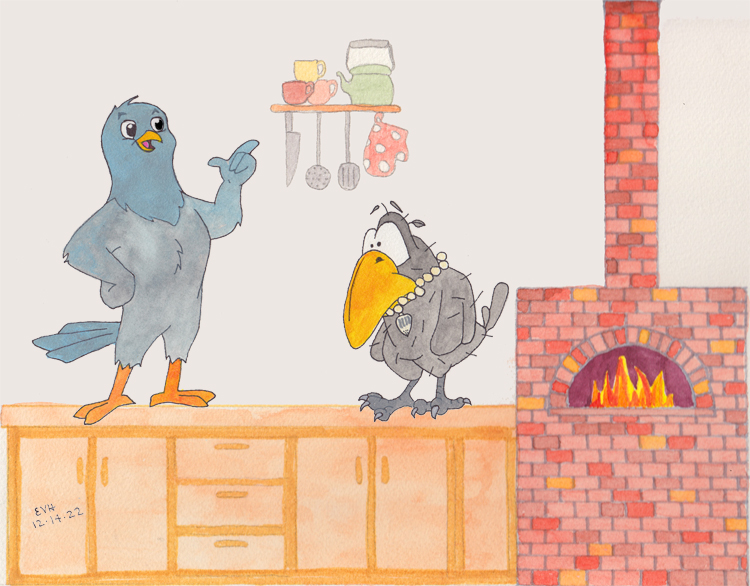
Jataka 395
Kāka Jātaka
The Crow
as told by Eric Van Horn
originally translated by H.T. Francis and R.A. Neil, Cambridge University
originally edited by Professor Edward Byles Cowell, Cambridge University
This story builds on Jātaka 42 in which a greedy crow is caught by a cook when the crow tries to steal some food from the kitchen. In this version of the story, the crow tries to hide his misdeed from his companion, a wise pigeon who also happens to be the Bodhisatta. It’s a poor choice.
“Our old friend.” The Master told this story while he was living at Jetavana. It is about a greedy monk. The occasion is as above (Jātaka 42).
Once upon a time when Brahmadatta was reigning in Benares, the Bodhisatta was a pigeon. He lived in a nest-basket in the kitchen of a Benares merchant. A crow became friendly with him. He also lived there. Here the story is to be expanded. The cook pulled out the crow’s feathers and sprinkled him with flour. Then he pierced a sea shell, hung it on the crow’s neck, and threw him into a basket. The Bodhisatta returned from the wood, and seeing him, ridiculed him and spoke the first stanza:
Our old friend! Look at him!
A jewel bright he wears.
His beard in gallant trim,
How gay our friend appears!
The crow—hearing him—spoke the second stanza:
My nails and hair had grown so fast,
They hampered me in all I did.
A barber came along at last,
And of superfluous hair I’m rid.
Then the Bodhisatta spoke the third stanza:
Granted you got a barber then,
Who has cropped your hair so well.
Round your neck, will you explain,
What’s that tinkling like a bell?
Then the crow uttered two stanzas:
Men of fashion wear a gem
Round the neck—it’s often done.
I am imitating them,
Don’t suppose it’s just for fun.
If you’re really envious
Of my beard that’s trimmed so true,
I can get you barbered thus,
You may have the jewel, too.
The Bodhisatta—hearing him—spoke the sixth stanza:
No, ‘tis you they best become,
Gem and beard that’s trimmed so true.
I find your presence troublesome:
I go with a good-day to you.

Figure: The wise pigeon and the foolish crow
With these words he flew up and disappeared, and the crow died then and there.
After the lesson, the Master taught the Four Noble Truths. After the teaching, the greedy monk was established in the fruition of the Third Path (non-returner). Then he identified the birth: “At that time the crow was the greedy monk, and I was the pigeon.”
